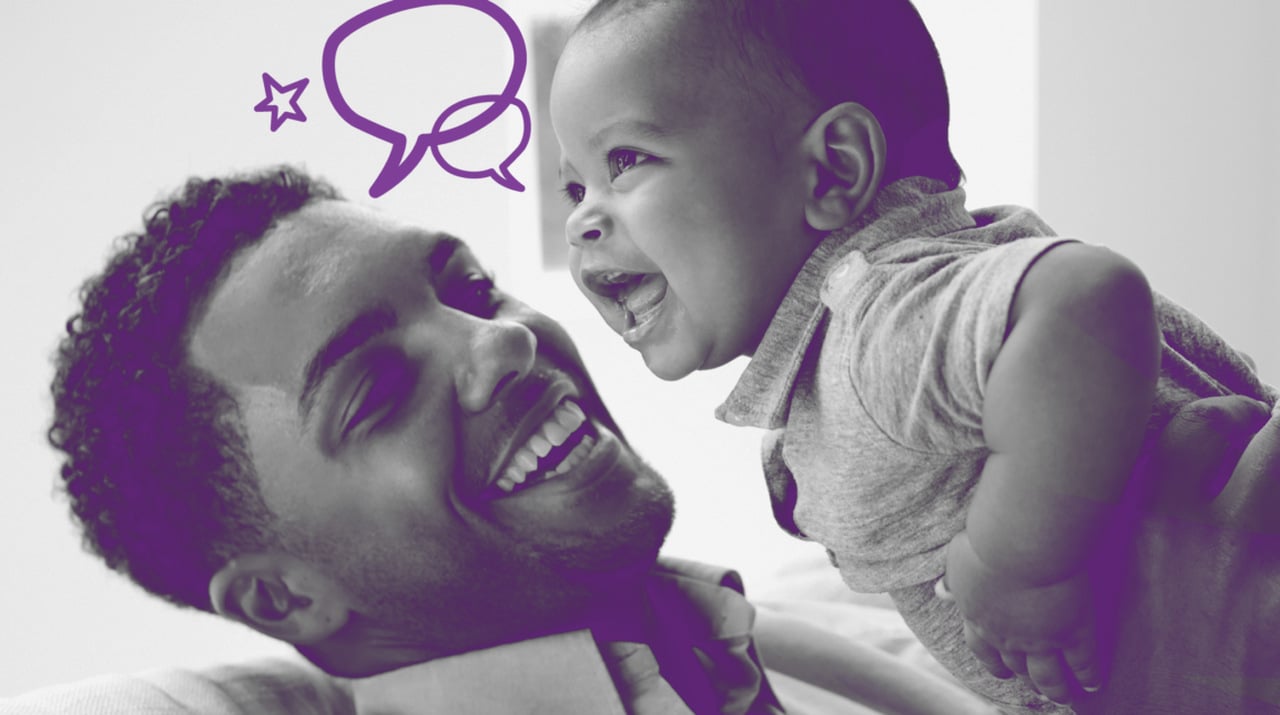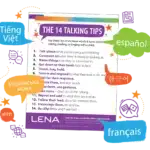Here’s something to keep in your back pocket for trivia night: The word “infant” derives from the Latin word infans, meaning “unable to speak.”
You might think, then, that when we encourage you to engage in conversation with an infant, we’re sending you on a fool’s errand.
We’re not.
An infant’s coos, grunts, and babbles — along with your reactions to those sounds — lay the foundation for everything to come. After all, an infant’s brain is forming more than 1 million new neural connections with every passing second. Achieving conversational turns with them is among the most important ways to jumpstart their language development and build the habit of focusing on interactions.
The positive effects of early talk compound quickly. The infant who’s responding to your “parentese” today will be a toddler before you know it. They’ll start asking countless “why” questions, inventing stories about friendly monsters, making very specific food requests, and doing all kinds of other unpredictable things. And if you create conversational turns with them when they’re a toddler, their teenage self — with their higher IQ scores and more advanced vocabulary — will thank you later.
It’s never too early. Research shows that talking even to babies born prematurely while they’re in the NICU is associated with better cognitive outcomes in the second year of life. Proper babbling usually only begins in months 5-8, but it’s important for us to remember that an infant’s first vocalizations occur from the very beginning.
How does LENA capture infant “talk”?
The LENA device can differentiate among a number of different sources of sound an infant might encounter. Some of those sounds are pretty easy to wrap your head around. Adult segments, for instance, include any post-pubescent human voices within range of the device. Electronic sound segments include anything coming from a device that has an electronic speaker — radios, televisions, battery-powered toys, and the like.
![]()
And then there are also secondary segments to consider, such as ambient noises, silence, nearby children, and overlapping sounds, when an adult’s voice might be competing with a television or a child and an adult might be talking at the same time.
Finally, there’s the subject at hand: the sound originating directly from the child who’s actually wearing the device. The LENA device picks up the whole spectrum of sounds an infant is likely to produce: babbles, raspberries, grunts, burps, loud breaths, cries, screams, laughs, and whatever else they might surprise us with. When it comes time for the software to arrive at a definitive “child vocalization count,” though, only the speech-related noises count. That means the babbles are in and the burps are out.
How can adults create more conversational turns with infants?
Along with LENA’s own research, many independent studies have homed in on the biggest predictor of faster language development in children. It’s not just how much the adult is talking or how many sounds the child makes. Rather, it’s the two working in concert. Everything hinges on the conversational turn.
On the face of it, a conversational turn is such a simple, impermanent thing — any alternation between a child and an adult that takes place within a five-second span. But it’s also a complex, indestructible building block.
An infant’s brain is going to get built one way or another. The more conversational turns we achieve, the stronger the foundation will be. The adults in an infant’s life have such a big impact.
How, then, do you actually have a conversation with an infant? Whether you’re a first-time parent or a seasoned caretaker, it can seem daunting. Or silly. Or exhausting. But when you get it right, it can also be magical.
Here are a few ideas for how to do it (along with some pointers about how to keep LENA’s 14 Talking Tips in mind as well):
Make time for one-on-one
The building blocks of language get built faster and stronger when you’re interacting with an infant one-on-one. You might think that just being in the presence of conversational turns among adults or between adults and other children would work wonders, but it doesn’t. Or, we should say, the results of group social interactions pale in comparison to the results of one-on-one exchanges.
Why?
Because one-on-one interactions are the ones that allow you, the adult, to respond to the child contingently. Since your attention is focused solely on the child, you can react to their movements, their vocalizations, and their facial expressions. Infant-directed talk is much more likely to result in shared attentional focus than indirect talk. You’ll be able to wait a sufficient amount of time for the child to react, and you’ll be able to react to and expand on what the child is saying and doing. In fact, one fascinating study found that parent/child brainwaves synchronize when they play together.
When it comes to concentrating on the one-on-one interactions, here are some of the 14 Talking Tips to keep in mind:
- Tip #4: Get down to their level: face to face. Communication benefits from proximity and eye contact. If you want to create joint attention with an infant, get down on their level.
- Tip #10: Take turns — don’t do all the talking. LENA’s “talk pedometer” is a patient piece of technology. If a baby responds to you within five seconds, it’s counted as a conversational turn. That means you can take your time as you wait for their brains to process the conversation!
Find the tone that works for you (there’s no right one)
Parentese — with its slower tempo, higher pitch, simpler phrases and grammar, and exaggerated facial movements — is among the easiest languages to master. Many parents find it a natural impulse to switch over to parentese when they’re holding an infant in their arms.
If you’re one of those parents, great! If you’re not, we have some good news for you: There’s no one right way to talk to an infant.
What matters is that you’re piquing their interest and motivating them to imitate the sounds you make.
Here are few ideas from the 14 Talking Tips to help you find your tone:
- Tip #1: Talk about what you’re doing and thinking. Take the baby along as you go about your daily activities and describe what you’re doing. Put everything into context and let your inner monologue come out. Bonus: You may find that slowing down and describing what you’re doing helps you feel more relaxed, too!
- Tip #3: Name things that they’re interested in. Notice what is capturing their attention and talk about it. You could make up a sing-song rhyme about it — it doesn’t have to be perfect poetry to delight a baby! Or, if sing-song rhymes don’t come naturally to you, you could wonder aloud about more serious things — like the science behind the bubbles your baby is staring at, or how difficult it was to hang that mobile that’s captured your baby’s attention, or anything else!
- Tip #9: Make faces, use gestures. It might sound counterintuitive, but nonverbal communication and conversational turns work very well together. When you use exaggerated faces and gestures, you’ll find your baby’s attention kicking into gear automatically.
Read, read, and read some more (and go beyond the words on the page)
Reading aloud to a child is the most surefire way to make your adult word count skyrocket. That’s not all it does, though.
Books are the ultimate “conversation starters” for children. They’re so much more than the words and pictures on the page. They’re an invitation to react out loud, to point and laugh, to engage the child. If ever it seems exhausting to talk with an infant, just remember that a book is like a cheat code. Other people — the author and illustrator — have already done the heavy lifting. Your job is simply to point at and say a little extra about the mischievous main character in “Goodnight Gorilla,” or to exaggeratedly count the number of trees in the background of “The Little Engine That Could.”
Here are some of the 14 Talking Tips to keep in mind when you’re reading with an infant:
- Tip #5: Touch, hug, hold. Physical affection stimulates the brain. It’s not just something to be reserved for times when a baby is upset. It’s the perfect accompaniment to a good book.
- Tip #6: Tune in and respond to what they look at, do, and say. When you’re paying attention to what’s capturing the baby’s attention, you can turn even a short book with just a handful of words into a long conversation.
- Tip #14: Be silly! Relax and have fun! Infants will reward your whacky faces and silly voices with smiles, laughter, and sounds of their own. When a baby is laughing, it’s a good indication you are communicating right on their developmental level.
A final word on talking with infants
It’s only been over the last 25 years that researchers have widely tested the hypothesis that talking with infants jumpstarts their language development, thanks in no small part to LENA technology. The findings are clear: Making time for one-on-one interactions with infants, responding to their cues (even if it’s just a grunt or a “raspberry”), and evoking reactions and imitations from them all contribute to the rate at which their language skills take shape. That means everything from developing phonological awareness to understanding the basic rules of spoken language.
The question isn’t whether an infant’s language development benefits from increased early talk. Rather, the question is how many other benefits there are and what their magnitude might be. That’s what the next 25 years of research (and beyond) will uncover. In the interim, we should all keep talking away.
[callout]



